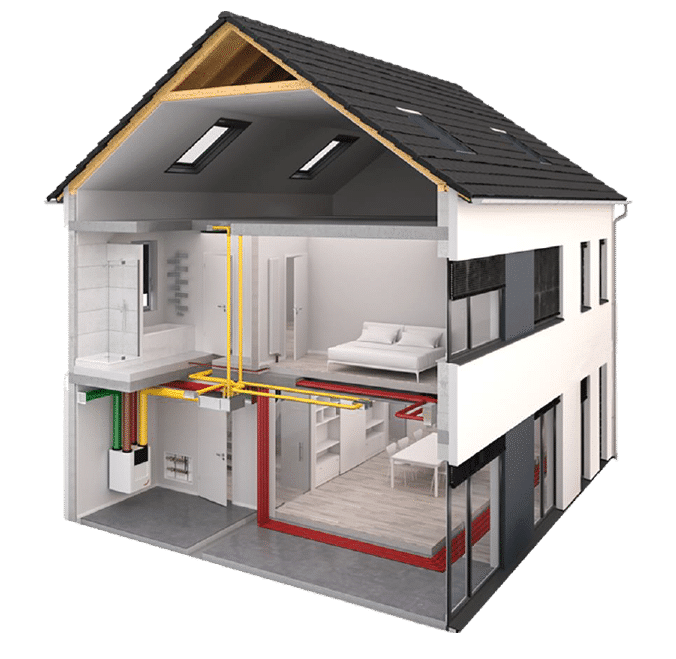Top FAQs About HRV Explained
Wiki Article
Discovering the Perks of Heat Recovery Ventilation for Energy Efficiency in Houses
Heat Recovery Ventilation (HRV) systems use property owners a practical strategy to boosting power effectiveness. By recovering warmth from outgoing air, these systems can substantially minimize heating & cooling costs. Furthermore, they offer a steady supply of fresh air, improving interior air quality and convenience degrees. As homeowners think about sustainable alternatives, understanding the subtleties of HRV systems ends up being progressively vital. What variables should one evaluate prior to making such a financial investment?Recognizing Heat Recovery Ventilation Solutions

Just How HRV Boosts Indoor Air Quality

Energy Financial Savings: The Economic Benefits of HRV
Making the most of energy performance, heat recovery ventilation (HRV) systems supply significant economic benefits for property owners. By recovering and recycling warm from exhaust air, HRVs significantly lower home heating and cooling prices. This innovation can bring about energy cost savings of approximately 30%, relying on environment and usage patterns. Home owners usually discover reduced utility costs soon after go right here installment, making HRVs an economically sensible investment in time. Furthermore, several areas offer rewards or discounts for energy-efficient upgrades, even more improving the monetary charm. As power costs remain to rise, the cost-effectiveness of HRVs comes to be increasingly clear. Overall, the consolidation of HRV systems not just advertises power performance however likewise adds to long-term economic savings for households.The Environmental Effect of Heat Recovery Ventilation
A substantial ecological benefit of heat recovery ventilation (HRV) systems depends on their ability to reduce total energy usage. By recovering warmth from exhaust air and transferring it to incoming fresh air, HRV systems reduce the need for energy-intensive home heating and cooling down methods. This reduction in power need adds to reduce greenhouse gas emissions, as much less nonrenewable fuel source is required to keep comfy indoor temperature levels. Additionally, HRV systems improve interior air quality by efficiently trading stale air with fresh outside air, lowering dependence on mechanical air conditioning systems that can hurt the atmosphere. On the whole, the implementation of HRV systems sustains lasting living practices and lines up with global initiatives to battle environment adjustment by advertising power efficiency in household settings.
Picking the Right HRV System for Your Home
Just how can home owners ensure they choose the best heat recovery ventilation (HRV) system for their needs? First, they must evaluate their home's dimension and format, as these elements affect air movement demands. Next off, reviewing the system's effectiveness ratings is vital, as greater scores indicate much better efficiency and power cost savings. Property owners need to also consider installation and maintenance costs, comparing different brand names and models for value. In addition, it is very important to review sound levels, as some systems operate even more silently than others. Consulting with heating and cooling experts can give tailored referrals based on certain home conditions. Checking out customer testimonials and guarantees can assist in making an educated decision, making sure that the selected HRV system efficiently boosts indoor air high quality and power performance.Frequently Asked Concerns

Just how Often Should I Tidy or Keep My HRV System?
The frequency of cleansing or maintaining a warmth healing ventilation (HRV) system generally depends on usage and ecological aspects. Normally, it is suggested to carry out upkeep every six months to ensure peak efficiency and air quality.
Can HRV Systems Help In Reducing Humidity Levels Indoors?
HRV systems can efficiently minimize interior humidity degrees by exchanging stagnant, humid air Clicking Here with fresh, drier air from outdoors. HRV Heat Recovery Ventilation. This process aids keep a balanced interior setting, enhancing convenience and avoiding moisture-related issues
What Is the Lifespan of a Typical HRV System?
The life-span of a common heat recovery ventilation (HRV) system differs, generally lasting between 10 to 15 years. useful site Routine upkeep can expand its efficiency and functional life, making sure peak performance throughout its use duration.Are There Any Kind Of Sound Worries With HRV Equipments?
Noise worries with HRV systems can develop, specifically from fan procedure. Several contemporary systems are developed to decrease audio levels, ensuring they operate silently while keeping effectiveness, which addresses potential disturbances in living atmospheres.Can I Set Up an HRV System Myself, or Do I Required a Specialist?
The individual contemplated whether to mount the heat recovery ventilation (HRV) system personally or hire an expert. Normally, while do it yourself installment is feasible, expertise guarantees appropriate performance and compliance with local structure codes, boosting system effectiveness.Report this wiki page